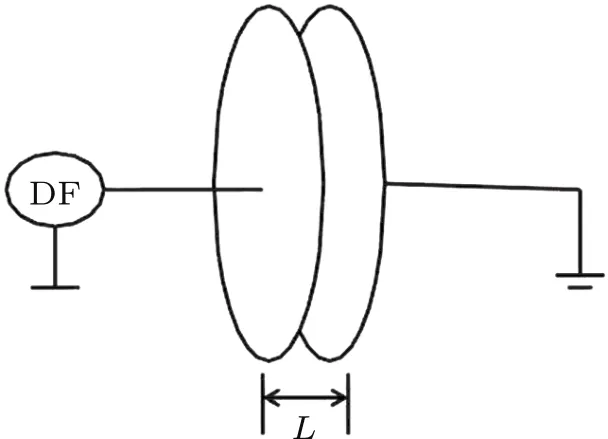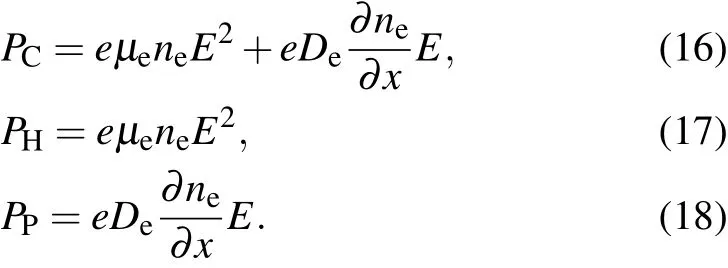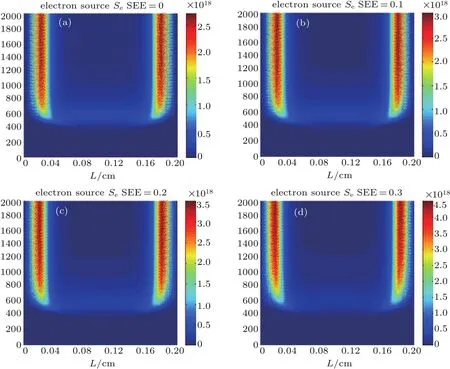Effects of secondary electron emission on plasma characteristics in dual-frequency atmospheric pressure helium discharge by fluid modeling∗
Yi-Nan Wang(王一男),Shuai-Xing Li(李帅星),Yue Liu(刘悦),and Li Wang(王莉)
1 College of Science,Liaoning Shihua University,Fushun 113001,China
2 Key Laboratory of Materials Modification by Laser,Ion and Electron Beams(Ministry of Education),Dalian University of Technology,Dalian 116024,China
Keywords:dual frequency,secondary electron emission,atmospheric pressure discharge
1.Introduction
It is difficult to control the plasma density and ion energy separately in the radio frequency(RF)capacitively coupled plasma(CCP).However,the dual frequency CCP system is able to achieve separate control of the plasma density and ion bombarding energy.[1-3]The dual frequency CCP system is extensively applied in many fields of materials.In this kind of system,one frequency is chosen to be much higher than the other.The high frequency(HF)source determines the plasma density,and the ion energy depends on low frequency(LF)source.[4,5]Considerable research has been carried out experimentally and theoretically on the dual frequency CCP system for the purpose of improving the efficiency of materials processing.[6-8]
Recently,the dualfrequency CCP system hasreceived extensive attention at atmospheric pressure.Many groups have begun to study the characteristics of dual frequency discharge plasmas in many fields to make them attractive for several purposes.[9-12]Waskoening et al.[12]studied the plasma ionization and associated mode transitions in dual-frequency helium discharge at atmospheric pressure.Kim et al.[13]experimentally studied 13.56 MHz/2 MHz dual frequency in atmospheric pressure corona plasma.Compared with the single frequency plasmas,the gas temperature was nearly same,and there were three discharge modes,positive streamer mode of 2 MHz,negative glow mode of 2 MHz,and continuous glow mode of 13.56 MHz.Zhang et al.[14]used a numerical method to study the discharge mode transition and electron heating mechanism in argon dielectric barrier discharge(DBD)driven by dual frequency at atmospheric pressure.They found that the electron energy distribution was effectively modulated by variation of the ratio of the lower frequency component.Liu et al.[15]studied the DBD driven by 13.56 MHz/200 kHz dual frequency at atmospheric pressure.They found the RF electric field could improve stability and uniformity at the same time.Despite this research,much of the effects of discharge parameters and the physic processes remain unknown.
The secondary electron emission(SEE)coefficient is an important parameter for material processing technology.As is known to all,the surface properties of materials,a particle’s incidence angle and energy will in fluence the SEE coefficient to some extent.Greb et al.[16]studied the impact of changing surface conditions including the SEE coefficient on plasma dynamics and the electron heating.They found that the surface condition significantly in fluences the characteristics of plasma.Schulze et al.[5]studied the secondary electrons in dual frequency capacitive radio frequency discharges.They reported two fundamentally different types of dual frequency at different secondary yields,γ.Shang et al.[17]studied the atmospheric pressure RF glow discharge between two coaxial electrodes.They presented that the gas ionization is strongly in fluenced by SEE coefficient in γ mode.Nevertheless SEE coefficient makes no difference to it in the α mode.Due to an ion’s impact on the electrode surfaces,Barkahoum et al.[18]reported that the SEE is a significant factor to describe the electrical properties in a discharge.Wei et al.[19]used a fluid model to study the in fluence of secondary electron emission coefficient on dielectric barrier pulsed discharge at atmospheric pressure.They found both the averaged current density in the cathode falling region and the averaged current density in the gap decrease with an increasing SEE coefficient.
In the atmospheric pressure environment,the mechanism of dual frequency discharge has not been fully understood and the fundamental studies are performed rarely.The plasma characteristics depend on the discharge conditions such as electrode distance,gas pressure,driven source,and so on.To simulate different surface conditions,the secondary electron emission coefficient was varied in the model.In some previous works,simple surface conditions of the electrodes are chosen and the effect of SEE is neglected in simulations.In this work,a fluid model including SEE coefficient is used to gain further insight on their fundamental impact on the characteristics of plasma driven by dual frequency in quantitative terms.
2.Model
In this paper,the helium plasma is generated in the parallel-plate electrodes as shown in Fig.1,where L is the electrode gap.The left electrode is driven by dual frequency source(at x=0),and the rightelectrode isgrounded(at x=L).The fluid model is used to describe the behavior of plasma by a series of equations including continuity equation,momentum equation and energy equation.In atmospheric pressure discharge,drift-diffusion approximation is used to describe the particle flux instead ofmomentum equation.The electrode gap is much smaller than the diameter of the electrodes,thus 1D fluid model is adopted.The reactions as same as our previous work of Ref.[20]in helium gas discharge are listed in Table 1.Some assumptions of this model are taken from Ref.[20].

Fig.1.Schematic diagram of the dual-frequency capacitively coupled plasma reactor.
Based on these assumptions the helium discharge can be described as follows.The continuity equation for particles is

where n,J,and S represent density,particle flow density,and particle source term,respectively.And the subscripts e,i,and∗denote electron,ion,and metastable,respectively.The driftdiffusion approximation replaces of the momentum equation,thus the particle fluxes can be written as

whereµand D are mobility and diffusion coefficient,respectively,whose values come from Refs.[21]-[23].E represents electric field.The electron energy equation is

On the right-hand side of Eq.(3),qerepresents the electron thermal flow,the second term is the heating term,and the last term is the energy loss term.

Here k is Boltzmann coefficient.e is elementary charge.Keis the thermal conductive coefficient.Hidenotes the electron energy loss coefficient for ionization.
The Poisson equation satis fies

The electric field derives from

where the ε0is the vacuum permittivity of free space.The initial conditions are

The boundary conditions are as follows:

Here ksis the electron surface recombination coefficient calculated assuming an electron sticking coefficient of unity,γ is the secondary electron emission coefficient for ions.V=VHsin(2π fHt)+VLsin(2π fLt)is the external voltage applied to the left electrode,where the subscripts H and L,respectively,represent the High Frequency(HF)source and Low Frequency(LF)source.We use an implicit center different scheme to solve all of the equations mentioned above.
3.Results and discussion
In this simulation model,helium is chosen as working gas at constant temperature of 300 K.The basic parameters are the background gas pressure p=760 Torr(1 Torr=1.33322×102Pa)and the electrode distance L=0.2 cm.The voltage of HF source is VH=500 V and the voltage of the LF source is VL=300 V.The frequency of the HF source is fH=27.12 MHz and the frequency of the LF source is fL=2 MHz.The simulations are performed at different values of γ.The secondary electron emission coefficient is constant for a certain material,based on the experiment and simulation results,[22,24-26]we keep VHconstant and the secondary electron emission coefficients γ within the range from 0 to 0.3.Due to the higher value of VHat p=760 Torr,the effective acceleration of secondary electrons inside the sheaths leads to a divergence in simulation at the highest values of γ,which would correspond to instabilities or arc formation in an experiment.[5]Thus the highest secondary electron emission investigated is 0.3.
The exactness and suitability of the model was verified by comparing with experimental results.Figure 2 gives the waveforms of applied voltage(solid)and plasma current(dash)in stable discharge stage during two cycles of low frequency.TLis the cycle of low frequency source.Both the applied voltage and the plasma current are predominately sinusoidal and the current leads the voltage by a phase shift of less than 90°,which are similar to the experimental results of Ref.[27].

Fig.2.The waveforms of applied voltage(solid)and plasma current(dash),V H=600 V,V L=100 V,f H=27.12 MHz,f L=2 MHz.
According to our previous results,[20]the main ions in the atmospheric pressure helium discharge are theions.Thus,the cycle-averaged spatial distributions ofion are shown in Fig.3(a)at different SEE coefficients in the 2000th cycle.As the secondary electron emission coefficient increasing from 0 to 0.3,the density ofion increases from 4.3×1012cm-3to 5.7×1012cm-3.The corresponding electron density is shown in Fig.3(b).The electron density resembles the density ofbecause of the electric neutrality of plasma. It can be clearly seen that the metastable atom He∗density increases as SEE coefficient increasing in Fig.3(c).The products of metastables are enhanced near the plasma/sheath interface,which results in the peaks of metastable atom He∗density appearing at the same positions on account of higher electron temperature(see Fig.4(a)).In the bulk plasma metastable pooling(R5 and R6)and step-wise ionization(R3)enhance the losses of metastables,from Table 1,R5=k5n∗n∗,R6=k6n∗n∗,and R3=k3nen∗.

Fig.3.The profiles of cycle-averaged(a)ion,(b)electron,(c)metastable atom He∗with the SEE coefficient of 0,0.1,0.2,and 0.3 in the 2000th cycle,respectively.V H=500 V,V L=300 V,f H=27.12 MHz,f L=2 MHz.
The cycle-averaged electron temperature and electric field spatial distributions with the SEE coefficient of 0,0.1,0.2,and 0.3 in 2000th cycles are shown in Fig.4.There is a steep gradient near the plasma/sheath interface and the peaks of electron temperature appear at the same positions.In the sheath regions,the electron temperature and electric field increase greatly with the SEE coefficient increasing.However,electron temperature and electric field are almost constant for allSEE coefficients in the bulk plasma.Itcan be explained that additional electrons from the wall are accelerated and multiplied in the sheath,which increases the number of high energy electrons and the efficiency of multiplication in the sheath.Thus,the sheath becomes smaller and closer to a hard wall because of a higher plasma density.Since the same amount of potential is dropped over a smaller distance,the sheath electric field increases.Although the electron temperature increases greatly with SEE,the thickness of the sheath region reduces very slightly.It because that the thickness of sheath is relevant to density of ions rs∝1/We can see from Fig.3(a)that the density of ions has changed slightly in the sheath.Therefore,the thickness of the sheath region reduces slightly.

Fig.4.The profiles of cycle-averaged(a)electron temperature,(b)electric field under different SEE coefficients V H=500 V,V L=300 V,f H=27.12 MHz,f L=2 MHz.
In low pressure RF discharge,the mechanisms of electron heating are in fluenced by SEE coefficient.[28-32]In this work,we also focus on the mechanisms of electron heating in dual frequency discharge.Based on the electron energy equation,the mechanism of electron heating PC=-eJe·E,labeled as PC,can be written as:

Here,PHand PPrepresent the electron ohmic heating and collisionless heating.[28,31]As a result of the inelastic collisions between electrons and neutral particle the electron energy dissipation,labeled as PL,can be written as

The mechanisms of electron heating corresponding to the 2000th cycle in the steady state discharge with different SEE coefficients are shown in Fig.5.From Fig.5(a),we can see that the collisionless heating is positive or zero in the bulk plasma,and it is negative in sheath region.With the SEE coefficient increasing from 0 to 0.3,the peaks of the collisionless heating PPincrease in sheath,nevertheless in the bulk plasma the collisionless heating PPhas not changed with all the investigated SEE coefficients.This is due to the fact that the important factor is the gradient in the electron density,a greater increase in electron density always occurs in the sheath edge region and the flat shape of electron density in bulk plasma.Figure 5(b)gives the electron ohmic heating with the SEE coefficient varied from 0 to 0.3.The electron ohmic heating mechanism is increasing as the SEE coefficient increased.This is because the electron density increases,which results in the higher conduction current and higher power absorption.Obviously,the electron ohmic heating is dramatically in fluenced by the SEE coefficient.As the SEE coefficient increases,the electron ohmic heating increases in the whole discharge gap.Figure 5 demonstrates that the secondary electron coefficient in fluence the electron ohmic heating much more than the collisionless heating.Similar results are found in radio frequency driven capacitively coupled oxygen plasma of Ref.[16],in which both the electron heating mechanisms exhibit a similar increasing trend with increasing secondary electron emission coefficient.

Fig.5.The cycle-averaged spatial distributions of(a)P P,(b)P H with the SEE coefficient of 0,0.1,0.2,and 0.3 in the 2000th cycle.V H=500 V,V L=300 V,f H=27.12 MHz,f L=2 MHz.
The electron heating PCcorresponding to the 2000th cycle with different electron secondary emission coefficients is shown in Fig.6.The electron heating PCis the sum of the electron ohmic heating and collisionless heating.Although the collisionless heating is negative in sheath regions,the electron heating PCincreases when the SEE coefficient increased due to the higher ohmic heating mechanism.The electron power dissipation is also a main mechanism of discharge and accordingly the electron power dissipation is shown in Fig.6(b).It is shown that the electron power dissipation increases as the SEE coefficient increased.This is due to the fact that the electron density increases as well.The electron temperature Fig.4(a)has the similar shape with the electron heating PC.Both of them have peaks in the sheath and constant in the bulk.It because the electron energy depends on electrons absorbing energy from the electric field.The electrons absorbing energy from electric field is indicated in the electron heating PC.As the SEE increases,the electron density in sheath increases,which results in the sheath of electric field increasing.Thus,both the electron heating and the electron temperature increase in the sheath as shown in Fig.4(a)and Fig.6(a).The calculation of the effects of SEE on PP,PH,PC,and PLhas a similar tendency to that in low-pressure argon discharge in Ref.[26].

Fig.6.The cycle-averaged spatial distributions of(a)P C,(b)electron power dissipation for different SEE coefficients in the 2000th cycle.V H=500 V,V L=300 V,f H=27.12 MHz,f L=2 MHz.
Figure 7 gives the evolution of electron source Sewith different SEE coefficients.The electron source is written as Se=k1neN+k3nen∗+k5n∗n∗-k7nenHe+2according to Table 1.We can clearly see that the electron source Sedepends on the SEE coefficient.The electron source Seincreases as the SEE coefficient increases.The larger the SEE coefficient is,the larger the electron source Sewill be.Moreover,the peak region of electron source Semoves to the electrode when the SEE coefficient changes.As the SEE coefficient increases,the sheath thickness decreases,the bulk plasma region enlarges.Besides,the electrons mainly gain energy from sheath’s electric field.Consequently the peak of electron source moves as the SEE coefficient changes.

Fig.7.The evolution of net electron generation with SEE coefficient(a)0,(b)0.1,(c)0.2,and(d)0.3.V H=500 V,V L=300 V,f H=27.12 MHz,f L=2 MHz.
4.Conclusion and perspectives
This work studied the effects of secondary electron emission coefficienton the dualfrequency helium plasma discharge at atmospheric pressure.The results show that the secondary electrons coefficient has an effect on dual frequency atmospheric pressure helium discharge.It is found that a large SEE coefficient can produce a higher density plasma as well as metastable density,sheath electric field,electron temperature and electron source term.Moreover,the SEE coefficient also in fluences the electron heating mechanism and electron power dissipation in the plasma and both of them increase with increasing SEE coefficient within the range from 0 to 0.3 as a result of increasing of electron density.
Acknowledgment
We would also extend our thanks to Dr.Li Li for her suggestion and encouragement in this work.
- Chinese Physics B的其它文章
- Superlubricity enabled dry transfer of non-encapsulated graphene∗
- Synthesis and characterization of β-Ga2O3@GaN nanowires∗
- Low-energy(40 keV)proton irradiation of YBa2Cu3O7-x thin films:Micro-Raman characterization and electrical transport properties∗
- Preliminary investigation on electrothermal instabilities in early phases of cylindrical foil implosions on primary test stand facility∗
- In fluence of low-temperature sul fidation on the structure of ZnS thin films∗
- Nonlinear behavior of the population dynamics of three-level systems in the presence of single photon absorption

